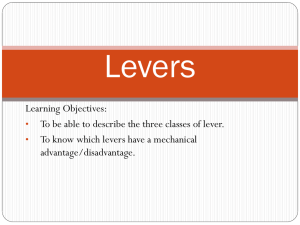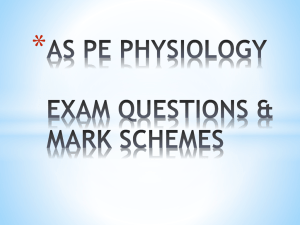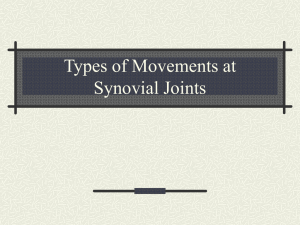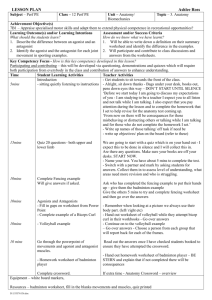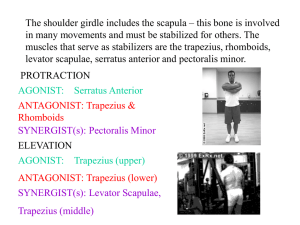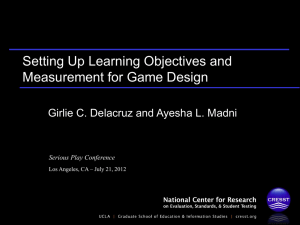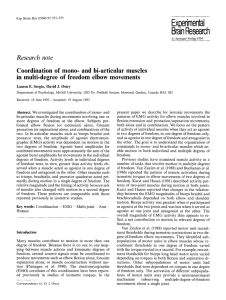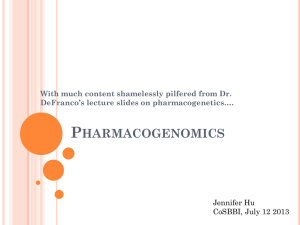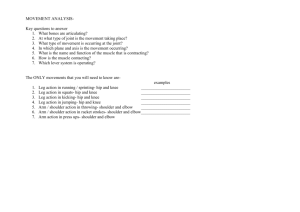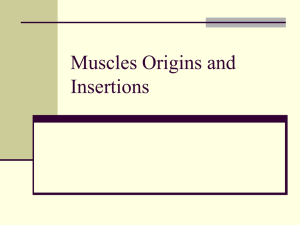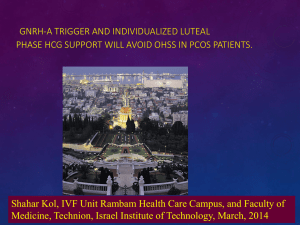File - PE Course Specification
advertisement
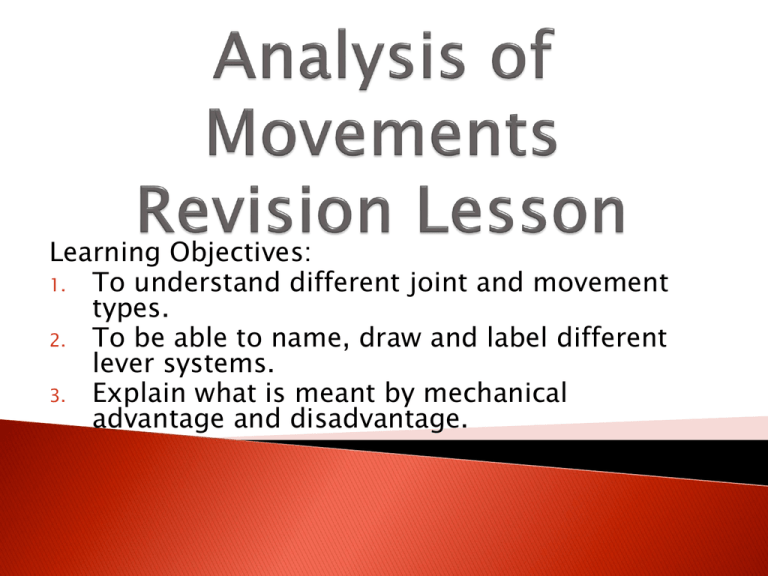
Learning Objectives: 1. To understand different joint and movement types. 2. To be able to name, draw and label different lever systems. 3. Explain what is meant by mechanical advantage and disadvantage. Most muscles work in antagonistic pairs. When one contracts, the other relaxes. The contracting muscle is called the prime mover (agonist), the relaxing muscle is the antagonist. These movements are stabilised by synergists. All muscle contractions are either isometric or isotonic (concentric/eccentric). Sagittal plane – forward and backward movements that take place around a transverse axis. E.g. bicep curls, sit ups. Frontal plane – side to side movements that take place around a frontal axis. E.g. abduction and adduction by raising or lowering a limb to the side. Transverse plane – turning movements that take place around a longitudinal axis. E.g. pronation (palm facing down) and supination (palm facing up). For a variety of sporting movements you need to be able to identify: The plane and axis over which the movement occurs The type of joint involved The bones meeting at the joint The joint action/type of movement The main agonist The leg action in running takes place in a sagittal plane about a transverse axis. The hip joint is a ball and socket joint. It involves the femur and the pelvis. This allows a full range of movement. The muscles pulling the upper leg backwards at the hip joint is the gluteals (the agonist during the drive phase). The muscles pulling the upper leg forwards at the hip joint are the hip flexors (the agonist during the recovery phase). The leg action in running takes place in a sagittal plane about a transverse axis. The knee joint is a hinge joint. It involves the femur and the tibia. This allows flexion and extension only. During the drive phase the leg is straightened by the quadriceps (agonist). During the recovery phase flexion is produced by the hamstrings (agonist). The leg action in running takes place in a sagittal plane about a transverse axis. The ankle joint is a hinge joint. It involves the tibia, fibula and talus. During running this joint allows flexion and extension. During the drive phase the foot points downwards (plantar flexion) as a result of the gastrocnemius muscle (agonist). During the recovery phase the foot is pulled upwards (dorsi flexion) as a result of the tibialis anterior (agonist). Jumping is very similar to the drive phase of running. Think about what is occurring at the hip, knee and ankle joints just before take off and then as the body drives upwards. Kicking can be separated into the preparatory phase and the kicking phase. During the preparatory phase the action is very similar to the recovery phase of running. During the kicking phase the action is very similar to the drive phase of running. In javelin throwing there are two phases. The withdrawal phase when the arm is extended backwards. The throwing phase when the actual throw occurs. Withdrawal Phase Throwing Phase Joint Joint Action Main Agonist Joint Action Main Agonist Elbow Extension Triceps Flexion then extension Biceps then triceps Shoulder Horizontal hyperextension Posterior deltoids Horizontal flexion Anterior deltoids and pectorals Note: The upper arm moves in a transverse plane around a longitudinal axis. The preparatory phase is the same as the withdrawal phase for the javelin throw. The striking phase is similar to the throwing phase for javelin except there is flexion is the elbow joint at the end of the follow through. The movements for squats and press ups can be analysed in the same way as the previous movements. However, exam questions are likely to now focus on whether the type of muscle contraction is concentric or eccentric. For example: lowering yourself downwards in a press up involves flexion of the elbow. Flexion is usually caused by the biceps but as this case involves a slow controlled movement with gravity it is actually the tricep working eccentrically (acting as a brake). The tricep is therefore the agonsit. In order to produce movement your muscles and bones work together as a series of levers. Levers involve: Fulcrum (pivot) – the point about which the lever rotates (the joint involved). Resistance (load) – the load that is being moved. Effort – the force applied by the person (the muscle that is the agonist). E.g. for a bicep curl the elbow is the fulcrum, the biceps produce the effort and the dumbbell is the resistance. First Class – fulcrum in the middle. Second Class – resistance in the middle. Third Class – effort in the middle. Remember FREE (minus an E of course!) Fulcrum in the middle. E.g. the elbow. During extension the triceps are the agonist (effort), the elbow is the fulcrum and the weight of the arm is the resistance. This occurs in throwing or during a press up. Resistance is in the middle. E.g. the foot. During dorsiflexion the ball of the foot acts as the fulcrum, the gastrocnemius provides the effort and the weight of the body is the resistance. This occurs when jumping or running. Effort is in the middle. E.g. Nearly every joint in the body. For example when performing a bicep curl the elbow is the fulcrum and the dumbbell is the resistance. The effort comes from the biceps which attach to the radius (between the fulcrum and the resistance). Force arm – distance between fulcrum and effort. Resistance arm – distance between fulcrum and resistance. When the force arm is very short and the resistance arm very long (as in third class lever) there is a mechanical disadvantage. For example, the biceps acting on the elbow joint cannot move large resistances. However, they also have an advantage that they can produce a large range of motion (nearly a full 180 degrees). They also have the advantage that only a small amount of bicep movement is required to produce a large amount of movement of the hand. Second class levers have a mechanical advantage. The force arm is longer than the resistance arm. E.g. during plantar flexion (standing on toes). They can generate much larger forces. However, the range of movement is small and the movements tend to be slow.
